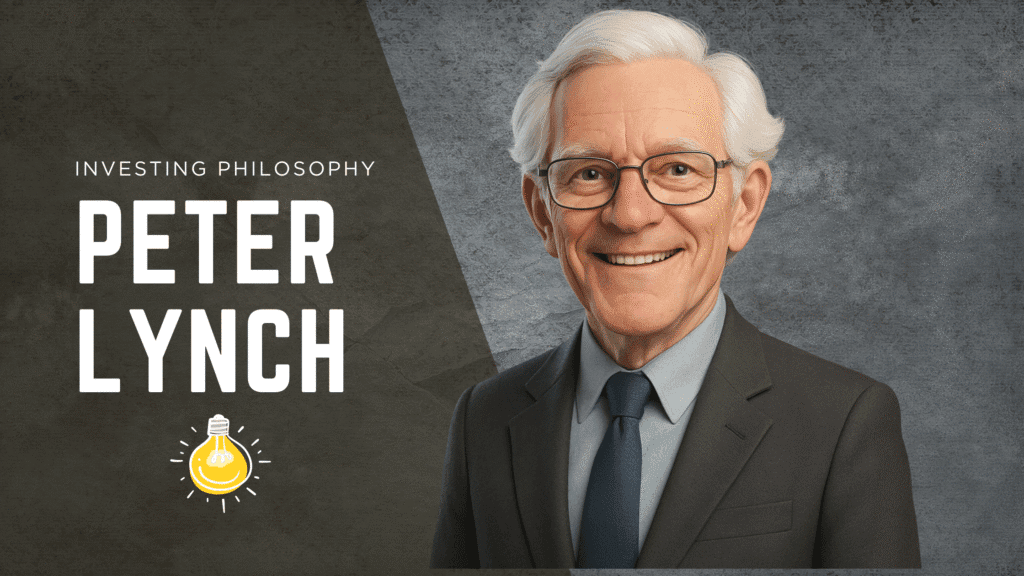A Beginner’s Guide to Value Investing in the Stock Market
I remember when I first started learning about the stock markets. It felt overwhelming. Every day, news channels shouted about stocks zooming up or crashing down, and I didn’t know how to make sense of it, because I didn’t have a framework or a system that I could lean on. I thought success lay in frantic activity, in constantly monitoring prices, and in mastering arcane formulas. I believed that since I was not smarter, faster, or possess more information than everyone else, there’s no way I could beat the market.

It took me a long time, and a lot of reading, to understand what investing really is. And more importantly, to discover a philosophy that just… made sense to me. It’s called value investing. It’s not a “get rich quick” scheme. It’s a “get rich slow” philosophy. It’s a framework for thinking, not a set of instructions. And here’s the best part: you don’t need a Ph.D. in finance to do it. You just need common sense, a bit of patience, and a willingness to learn.
The good news is that the wisest investors in history have left a breadcrumb trail for us. They’ve written books, given interviews, and penned letters full of wisdom. My goal is to take these powerful, simple ideas from tycoons like Warren Buffett, Charlie Munger, and Howard Marks and translate them into a practical guide for someone just starting their journey.
We’re going to cover what value investing is, the core pillars it stands on, and a step-by-step guide to how you can actually begin.
Here’s a quick look at where we’re going:
- What is Value Investing? (And What It’s Not)
- The Core Pillars of Value Investing: The “Big Ideas”
- Pillar 1: The Market is Crazy (Meet Mr. Market)
- Pillar 2: Your Safety Net (The Margin of Safety)
- Pillar 3: Know Your Playground (The Circle of Competence)
- Pillar 4: Think Like an Owner (It’s a Business, Not a Ticker)
- Pillar 5: The Hardest Part (Patience & Temperament)
- A Step-by-Step Guide to Starting Your Journey
- Final Thoughts: It’s a Marathon, Not a Sprint
1. What is Value Investing? (And What It’s Not)
Let’s start with a simple analogy.
Imagine you have a favorite brand of cereal. You buy it every week. You know it’s a quality product, and you’re happy to pay $5 a box for it. One day, you walk into the grocery store, and there’s a massive sale: the exact same cereal is on sale for $2.50.
What do you do? Do you panic and say, “Oh no, something must be wrong with the cereal!” and run away?
Of course not. You know the cereal is good. You know its value to you is $5. So you see the $2.50 price as a fantastic opportunity. You’d probably buy several boxes.
Congratulations, you’re a value investor.
That’s it. That is the entire philosophy in a nutshell. Value investing is the art and science of buying something for less than its real, underlying worth.
In the stock market, every “stock” is just a tiny piece of ownership in a real business. A “share” of Apple isn’t just a symbol (AAPL) that wiggles up and down on a screen; it’s you owning a tiny fraction of the entire company—its brand, its factories, its iPhone business, its future profits.
The value of that business is what it’s actually worth, based on how much cash it will make over its lifetime.
The price of that stock is simply what people are willing to pay for it today.
Sometimes, often, the price is fair. But sometimes, the price is much higher than the value. And sometimes, if you’re patient, the price is much lower than the value (a “bargain”).
A value investor is simply a business analyst who waits for a bargain.
What Value Investing is Not:
- It’s not day trading (buying and selling stocks in minutes or hours).
- It’s not “technical analysis” (trying to predict price moves by looking at chart patterns).
- It’s not following hot tips from a guru on TV or a stranger on the internet.
- It’s not gambling. It’s a disciplined process for reducing risk.
At its core, it’s a mindset. It requires you to be a little bit of a contrarian—to be skeptical when everyone is greedy and to be brave when everyone is fearful.
2. The Core Pillars of Value Investing: The “Big Ideas”
This philosophy was first taught by a man named Benjamin Graham (Warren Buffett’s professor) and has been practiced and refined by some of the greatest financial minds in history.
I’ve found that all their wisdom boils down to a few simple, powerful pillars. Let’s walk through them and break down the meaning of their wisdom.
Pillar 1: The Market is Crazy (Meet Mr. Market)
The stock market is, in the short term, a wild, emotional, and often irrational place.
The people buying and selling stocks every day are human. They get greedy, and they get scared. This collective emotion is what makes prices fly up one month and crash the next, even if the underlying businesses haven’t changed at all.
Howard Marks, a legendary investor, said it perfectly:
“Rule number one: Most things will prove to be cyclical. Rule number two: Some of the greatest opportunities for gain or loss come when other people forget rule one.”
Markets move in cycles, and so does emotion. Good times create optimism, which creates greed, which pushes prices to unsustainable highs. Bad times create pessimism, which creates fear, which pushes prices to ridiculous lows.
Benjamin Graham created a famous analogy for this. He said to imagine you are partners in a business with a man named “Mr. Market.”
Mr. Market is a manic-depressive.
Every single day, he comes to your office and offers to either buy your share of the business or sell you his, at a specific price.
Some days, Mr. Market is euphoric. He sees nothing but a glorious future. On these days, he offers to sell you his share for an outrageously high price.
Other days, Mr. Market is terrified and depressed. He’s convinced the business is doomed. On these days, he offers to sell you his share for a ridiculously low price, just to get out.
Here’s the secret: You don’t have to listen to him.
If his price is crazy-high, you can ignore him (or even sell to him). If his price is dirt-cheap, you can happily buy from him. But you are never forced to trade with him.
Mr. Market is her to serve you, not to guide you.
Most people get this backward. They let Mr. Market’s mood swings dictate their mood. When the price is high, they get greedy and buy. When the price is low, they get scared and sell.
A value investor does the opposite. They see Mr. Market’s moods as an opportunity. This is what Howard Marks meant by this quote:
“The thing I find most interesting about investing is how paradoxical it is: how often the things that seem most obvious-on which everyone agrees turn out not to be true.”
When “everyone agrees” that a stock is a “can’t-miss” buy, the price is probably too high. When “everyone agrees” a company is “doomed,” that might be the exact moment to look for a bargain.
Pillar 2: Your Safety Net (The Margin of Safety)
If Pillar 1 is understanding that the market gives you crazy prices, Pillar 2 is how you take advantage of it safely.
This is, without a doubt, the most important concept in all of value investing. It’s called the Margin of Safety.
Let’s go back to our cereal. The value is $5. The sale price is $2.50. The difference between the value and the price ($5.00 – $2.50 = $2.50) is your margin of safety.
Why is this so critical? Because, as Howard Marks said:
“Risk exists only in the future, and it’s impossible to know for sure what the future holds…”
You are going to be wrong. I am going to be wrong. We will make mistakes. We’ll overestimate a company’s value. We’ll miss a new competitor. A pandemic will come out of nowhere.
The margin of safety is your protection against our own stupidity and the world’s surprises.
Think of it like building a bridge. If you calculate that the bridge needs to hold 10,000 pounds, you don’t build it to hold exactly 10,000 pounds. You build it to hold 30,000 pounds. That’s your margin of safety.
In investing, if you calculate a business is worth $100 per share, you don’t buy it at $99. That’s “cutting it close.” You wait. You wait for Mr. Market to have a meltdown and offer it to you for $60.
Now, even if your $100 calculation was wrong, and the business is only worth $80… you still bought it at $60. You’re protected.
This concept completely redefines “risk.” To most people, “risk” means prices going up and down (volatility). To a value investor, risk is the chance of a permanent loss of capital. Buying a great company at a high price is risky. Buying a good company at a fair price or a cheap price is not.
This brings in another key idea: uncertainty. Most people hate uncertainty. Value investors love it. Why? Because, as Seth Klarman says:
“Yet high uncertainty is frequently accompanied by low prices. By the time the uncertainty is resolved, prices are likely to have risen.”
When a company is in the news for a (temporary) bad reason, uncertainty is high. People panic and sell, pushing the price down. This creates the margin of safety for the investor who has done their homework and can see the long-term value.
Joel Greenblatt succinctly summarizes this defense-first mentality: “If you don’t lose money, most of the remaining alternatives are good ones”.
Pillar 3: Know Your Playground (The Circle of Competence)
So now you know you’re looking for bargains. But… bargains in what?
This is where many beginners (including me, back in the day) go wrong. We hear about a “hot” stock in biotech or artificial intelligence and think we should invest.
But here’s the question: Do you really understand that business? Could you explain, in simple terms, how it makes money, who its competitors are, and why it will still be around in 10 years? Can you predict if the business will be around in 20 years?
If the answer is no, you must stay away.
Warren Buffett calls this idea the Circle of Competence. The concept is simple: everyone has a few areas of life or business that they understand reasonably well, just from their job, their hobbies, or their interests.
Maybe you’re a teacher, so you understand the education business. Maybe you’re a gamer, so you understand video game companies. Maybe you just drink a lot of coffee, so you can understand Starbucks.
Your job as an investor is not to be an expert on everything. It is to:
- Draw a circle around the things you genuinely understand.
- Stay inside that circle.
As Buffett says “Investors should remember that their scorecard is not computed using Olympic-diving methods: Degree-of-difficulty doesn’t count”.
You get no extra points for investing in something complex. In fact, you’re more likely to lose money. A “boring” company that makes snack foods, which you can analyze and understand, is potentially a better investment than a “revolutionary” tech company whose product you can’t explain.
The size of your circle doesn’t matter. Knowing its boundary is what’s vital.
This requires a deep level of intellectual honesty. It’s about saying “I don’t know,” which requires humility.
Pillar 4: Think Like an Owner (It’s a Business, Not a Ticker)
When you buy a stock, you are not buying a lottery ticket. You are not buying a blip on a screen. You are buying a fractional ownership stake in a real business.
This idea will change everything about how you invest. You stop asking, “What will the stock price do next week?” and you start asking, “How will this business perform over the next ten years?”
A stock-picker buys a stock hoping it goes “up.” A business analyst (which is what a value investor is) buys a business with the intention of holding it forever.
When you think like an owner, you start asking the right questions:
- How does this business make money? Is it durable?
- Does it have a “moat”? A moat is a competitive advantage, like a castle’s moat, that protects it from competitors. This could be a powerful brand (like Apple), a low-cost advantage (like Walmart), or a network effect (like Facebook).
- Is the management team good? Are they honest and talented? Do they think like owners too?
- Does the business have a lot of debt? Debt can be risky. and high indebtedness can lead to bankruptcy.
- What is the business worth?
This is the work. It’s not about watching charts. It’s about reading. You read annual reports, industry news, and competitor websites.
As Chuck Akre says, it’s a process of learning: “Good judgement comes from experience, and experience comes from bad judgement”
You’ll get better at analyzing businesses by doing it. Your first few attempts will be clumsy. That’s okay. You’re building a skill. Peter Lynch, another legend, once said:
“Your ultimate success or failure will depend on your ability to ignore the worries of the world long enough to allow your investments to succeed”
If you’ve done the work, and you’re confident you own a piece of a great business that you bought at a fair price… all you have to do is let that business do its job.
Pillar 5: The Hardest Part (Patience & Temperament)
This brings us to the final, and most difficult, pillar.
You can be a genius at math. You can be the world’s best business analyst. But if you don’t have the right temperament, you will fail as an investor.
What is temperament? It’s emotional control. It’s patience. It’s the ability to do nothing when all your instincts are screaming at you to do something.
Charlie Munger (Warren Buffett’s partner) said it best:
“The big money is not in the buying or the selling, but in the waiting.”
Once you buy a wonderful business at a great price, the hardest part is just… sitting on it. For years. Decades, even. You have to let the business compound its earnings. I wrote about the Magic of Compounding here if you’d like to explore further.
The world will try to stop you. The news will flash headlines of “WAR!” and “RECESSION!” and “CRISIS!” Your friends will tell you about the hot new stock they just bought. Your portfolio will go down (it will, I promise) and you’ll feel that pit in your stomach.
Your job is to ignore it all. This is what Peter Lynch meant by “ignoring the worries of the world.”
Howard Marks has a wonderfully dark but funny line about this: “The best investors are either dead or inactive”
People who forget about their investment accounts often do the best, because they aren’t tinkering. They aren’t selling when they’re scared or buying when they’re greedy. They are letting their businesses compound.
This is the ultimate paradox: the way to win this game is, most of the time, to just wait, and not play.
Charlie Munger had another great quote: “Invert, always invert.” Instead of asking “How can I be a great investor?” ask, “What do all the bad investors do?”
- They trade a lot.
- They buy what’s popular and expensive.
- They sell what’s unpopular and cheap.
- They panic.
- They follow tips.
- They don’t do their own homework.
- They invest in things they don’t understand.
Your job is to simply… not do those things.
3. A Step-by-Step Guide to Starting Your Journey
Okay, that was the philosophy. It sounds simple, right? But it’s not easy.
So, how do you actually start? If I were starting from zero today, here is the exact path I would follow.
Step 1: Get Your Financial House in Order. Before you invest one dollar in the stock market, you must do this.
- Pay off high-interest debt. I’m talking about credit card debt. You can’t earn 20% in the market, but you can lose it to interest. Pay it off.
- Build an emergency fund. This is 3-6 months of your living expenses, in cash, in a boring savings account. This is your real margin of safety. It’s what stops you from being forced to sell your investments at a bad time just because your car broke down.
Step 2: Read. A Lot. Make continuous, lifelong learning as your life’s mission. Here’s a list of things that will hopefully get you hooked:
- Warren Buffett’s Shareholder Letters: You can find them all for free on Berkshire Hathaway’s website. This is the single best education in business and investing.
- The Intelligent Investor by Benjamin Graham: This is the “bible” of value investing. It’s dense, but Chapters 8 (Mr. Market) and 20 (Margin of Safety) are mandatory.
- One Up On Wall Street by Peter Lynch: This is the most practical, fun-to-read investing book ever written. It will teach you how to find investment ideas in your everyday life.
- The Most Important Thing by Howard Marks: This is a masterclass on the “soft skills”—temperament, risk, and cycles.
This is just appetizers. If you’re hungry for more, check out this curated list of 125+ recommended books around investing, business, financial markets history, anthropology, science and topics. The best investors read like crazy!
Step 3: Learn the Language of Business (The Basics). You have to learn how to read financial statements. It sounds scary, it’s not. They’re just stories told in numbers. There are three “Big 3” statements:
- The Income Statement: Tells you if a company was profitable over a period (like a quarter or a year). Key line: Net Income (Profit).
- The Balance Sheet: A snapshot in time of what a company owns (Assets) and what it owes (Liabilities). Key idea: Assets – Liabilities = Equity (the company’s net worth).
- The Cash Flow Statement: The most important one! It shows where real cash came from and where it went. Profit is an opinion; cash is a fact.
You don’t need to be a Certified Public Accountant (CPA). You just need to know what you’re looking at. Websites like Investopedia can teach you the basics for free.
Step 4: Pick ONE Company and Do the Work. Pick one company from your list in Step 4. Go to its “Investor Relations” website and download the latest “Annual Report” (or “10-K”).
- Read the Management Discussion and Analysis section carefully.
- Read the “Business” section. (What do they actually do?)
- Look at the “Big 3” financial statements. Don’t worry about understanding it all. Just look. Is revenue (sales) going up? Is the company profitable? Does it have more assets than liabilities? Does it have a lot of debt? Does it have a decent cash conversion cycle? Does it convert its profits into free cash flow?
- This is your first “rep.” It will be hard. The second one will be easier.
Step 5: Try to Value It (Don’t Worry, Be Wrong). This is the hardest part, but you can start simple.
- There are several methods to value a business, such as DIscounted Cash Flow (DCF) analysis, EV/EBITDA, EV/FCF, P/E ratio or other similar metrics. Most of the times, using multiple valuation methods is better than using just one method. It will also give you a range of values which is better than having one precise valuation number.
- As Buffett says, its okay to be approximately right than completely wrong. Valuation is not an exact science, because there are too many variables.
- This is a vast topic, but it all comes down to one question: “What is this business worth?” And how different is the current market price compared to your valuation range? If there’s a small difference, it might not be worth the time and effort. If there’s a big difference, it might be worth investing.
Step 6: Make Your First Investment (with “Tuition” Money). Once you have done your homework, understood the business and believe it is selling for less than it’s worth (a Margin of Safety)….it’s time.
Take a small amount of money—an amount you are 100% willing to lose. Think of it as “tuition” for your education. Buy your first stock.
Now, you’re an owner. It will feel completely different. You’ll suddenly feel every up and down. This is where the real lessons in temperament (Pillar 5) begin.
Write down why you bought a stock. When it goes wrong (or right!), you can go back and check your thinking. Learn from it. Use this free investment journal to document your thoughts.
Step 9: Be Patient. Keep Learning. Forgive Yourself. You will make mistakes. I have. Buffett has. Everyone does. The best investors will be right 6 times out of 10. i.e. they are wrong 4 times out of 10 (an astonishing 40% failure rate!) As Howard Marks says: “Experience is what you get when you didn’t get what you wanted”
Step 10: Keep Turning Over Rocks. Repetition Builds Expertise. Here’s a secret no textbook tells you: the most important skill in investing is pattern recognition. And you only develop pattern recognition by looking at thousands of businesses. Value investors often talk about “turning over rocks.”
The idea is that great opportunities are rare, and you have to search through a lot of ordinary (or terrible) businesses to find one gem. You might analyze 20 companies and decide to invest in zero, and that’s a huge win! Why? Because every time you read an annual report, look at a balance sheet, and think about a company’s competitive “moat,” you are building mental muscle.
This repetition trains your eye to quickly spot common traps and recognize the signs of a truly high-quality business or a deeply mispriced bargain. Don’t stop researching just because you bought your first stock; keep that research engine running constantly. Because this is a lifelong process of learning, betting, iterating and improving.
4. Final Thoughts: It’s a Marathon, Not a Sprint
This is a long article, and it’s a lot to take in. But if you take away only one thing, let it be this: Investing is not about genius; it’s about common sense and patience.
The stock market is a machine that transfers wealth from the active, emotional, and impatient to the calm, rational, and patient.
Your job is to be in that second group. To think like an owner, to demand a discount, to stay in your circle, and to let the magic of compounding do the work for you. It’s a journey of a lifetime, and it’s one of the most rewarding ones you can take.
“Don’t wish it were easier, wish you were better.”
You can do this. The journey starts now.
To build this necessary framework, we turn to the essential lessons taught by the greatest value investors. These principles are architectural in nature; they form the blueprint for rational behavior in an irrational world.
Recap: The Six Maxims of Value Investing
The collective wisdom of masters like Warren Buffett, Charlie Munger, Ben Graham, and Howard Marks converges around a few immutable principles. These maxims define the temperament and strategy required for long-term success.
Table: The Six Maxims of Value Investing: Wisdom Distilled
| Theme/Maxim | Core Lesson | Key Supporting Quotes | Philosophical Anchor |
| Intrinsic Value | Focus on a business’s true worth, ignoring daily noise. A stock is an ownership interest in a business. | “Price is what you pay, value is what you get” (Buffett). “A stock is an ownership interest in a business” (Graham). | Business Ownership |
| Margin of Safety (Defense) | Buy at a discount to create a protective buffer against error and unforeseen events. | “Low price is the ultimate source of margin for error” (Marks). “The best defense against loss is thorough, insightful analysis” (Marks). | Risk Mitigation |
| Risk vs. Volatility | True risk is permanent loss or the probability of a bad outcome, not temporary price fluctuation. | “Risk comes from not knowing what you’re doing” (Buffett). “Volatility is not risk” (Marks). | Knowledge & Survival |
| Time & Compounding | Wealth is created slowly and requires extreme patience. The goal is to avoid unnecessary interruptions. | “The big money is not in buying or selling, but in the waiting” (Munger). “My life has been a product of compound interest” (Buffett). | Patience & Inactivity |
| The Crowd & Cycles | Recognize that market swings are driven by psychological extremes (greed/fear) that create opportunity. | “Be fearful when others are greedy. Be greedy when others are fearful” (Buffett). “Just about everything is cyclical” (Marks). | Contrarianism |
| Circle of Competence | Concentrate your effort on areas you deeply understand, avoiding unnecessary complexity. | “Know your circle of competence, and stick within it” (Buffett). “I look around for 1-foot bars that I can step over” (Buffett). | Humility & Edge |
Continue Reading
A Beginner’s Guide to Value Investing in the Stock Market
Stay Hungry, Stay Foolish: Transformative Lessons from Steve Jobs
Volatility Is Opportunity
Investing Principles for Aspiring Investors
Peter Lynch’s Investing Philosophy
Howard Marks’ Investment Philosophy
Shop Collectibles
‘Notebook of Wisdom’ with 160 Investing Quotes
Original price was: $99.00.$69.00Current price is: $69.00.AI Stock Research Checklist with Prompts
Original price was: $30.00.$15.00Current price is: $15.00.Canvas Print with Ben Graham Top 10 quotes and caricature
Original price was: $119.00.$89.00Current price is: $89.00.










